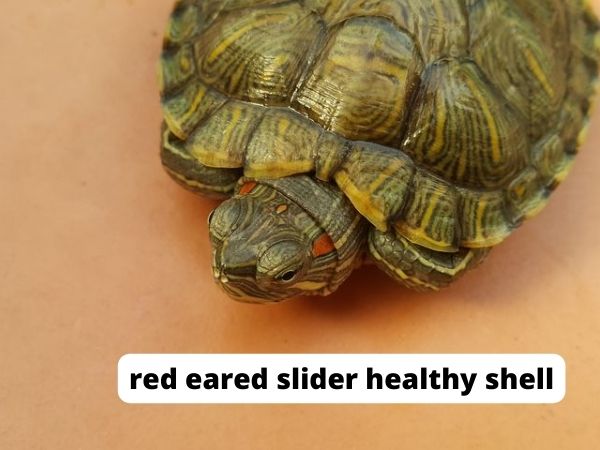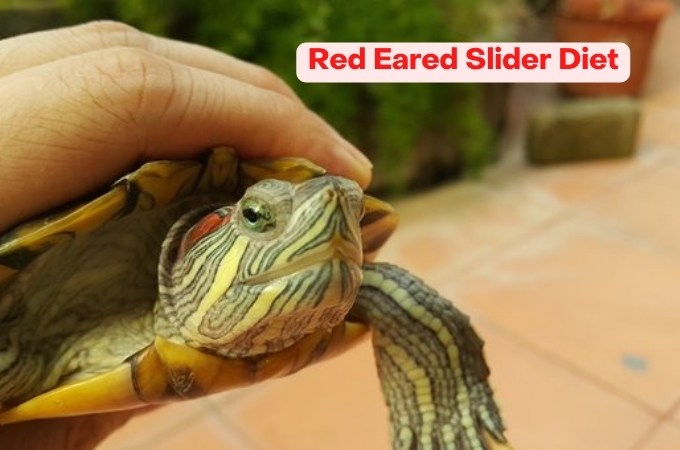Feeding Baby Red-eared Slider Turtles: Tips For Success
Today we discuss Feeding Baby Red-eared Slider Turtles. Feeding baby red-eared slider turtles can be an exciting adventure filled with important considerations. From choosing the right food to establishing a proper feeding routine, we’ve got you covered. So, let’s embark on this journey together and ensure the health and happiness of your tiny turtle friends.
Whether you’re a complete beginner or an experienced turtle enthusiast, this guide will provide you with the essential knowledge to nurture your baby red-eared sliders into thriving, vibrant pets. So, let’s roll up our sleeves and discover the secrets to feeding these delightful little reptiles!
Feeding Baby Red-Eared Slider Turtles:
Red-eared slider turtles, also known as Trachemys scripta elegans, are popular pets known for their vibrant red ear patches. If you are a proud owner of a baby red-eared slider turtle, providing the right diet is crucial for their growth and overall well-being. Feeding baby turtles can be a delicate task, as their nutritional needs differ from adult turtles. In this article, we will explore essential tips for successfully feeding baby red-eared slider turtles.
1. Understanding the Nutritional Needs:
Feeding baby red-eared slider turtles requires a thorough understanding of their nutritional needs. As hatchlings, their diet primarily comprises of protein-rich foods to support their growth. Offer small portions of protein sources such as commercially available turtle pellets, freeze-dried shrimp, dried insects, and earthworms. It’s important to feed them a variety of proteins to ensure a balanced diet.
In addition to proteins, baby red-eared slider turtles also require essential vitamins and minerals. You can provide these through leafy greens like kale, collard greens, and dandelion greens. Offer bite-sized pieces of these vegetables, ensuring they are washed thoroughly to remove any pesticides or harmful chemicals.
It’s essential to have a good mix of proteins and greens in their diet to ensure proper growth and development. Feed your baby turtle twice a day, offering a combination of proteins and leafy greens in each feeding session.
2. Providing Calcium and Vitamin D3 Supplements:
Calcium and vitamin D3 are crucial for a baby red-eared slider turtle’s shell and bone development. In captivity, turtles may not have access to direct sunlight, which they need to synthesize vitamin D3. Therefore, it is recommended to provide calcium and vitamin D3 supplements to ensure their nutritional needs are met.
You can sprinkle calcium powder with added vitamin D3 on their food a few times a week. Always follow the instructions provided by the veterinarian or reptile specialist to ensure proper dosage. Furthermore, monitor their shell development closely and consult with a reptile veterinarian if any abnormalities or deformities are observed.
Remember, supplements should not replace natural food sources. They are meant to complement the diet and provide additional nutrients to support the turtle’s overall health.
3. Importance of Proper Feeding Technique:
Feeding time is an opportunity for you to bond with your baby red-eared slider turtle. Using the right feeding technique ensures their safety and prevents any food-related issues. It’s essential to place the food in a shallow dish or a separate feeding container to avoid contamination of their habitat with uneaten food.
While feeding, make sure the food is bite-sized and easily consumed by the baby turtle. If using commercial turtle pellets, moisten them slightly to make them easier to swallow. Monitor their eating habits and remove any uneaten food promptly to prevent water pollution and bacterial growth.
Remember to provide fresh and clean water for your baby red-eared slider turtle at all times. Keeping their habitat clean and maintaining proper hygiene is crucial for their overall health and well-being.
4. Gradually Introducing New Foods:
As your baby red-eared slider turtle grows, it’s important to gradually introduce new foods to its diet. This helps prevent any potential digestive issues or food rejections. Begin by offering small portions of new foods alongside their familiar diet.
Introduce new protein sources, such as small pieces of cooked chicken or fish, as they grow older. Incorporate a wider variety of leafy greens and vegetables, such as carrots and bell peppers, to provide essential vitamins and nutrients. Pay attention to their preferences and adjust their diet accordingly, ensuring a balanced and healthy meal plan.
Remember, patience is key when introducing new foods. It may take several attempts before your baby turtle accepts and enjoys a new food item. Be persistent and observe their responses to ensure their dietary needs are adequately met.
5. Avoid Overfeeding and Obesity:
Overfeeding is a common issue among red-eared slider turtles and can lead to obesity, which poses health risks. It’s important to provide appropriate portion sizes and monitor their weight regularly. Baby turtles should exhibit steady growth, and their shells should remain smooth without any signs of pitting or deformities.
Avoid the temptation to feed your baby red-eared slider turtle too much or too frequently. Follow the recommended feeding guidelines provided by experts to prevent obesity-related health issues. If you notice abnormal weight gain or any unusual behavior, consult with a reptile veterinarian for guidance.
Regular exercise and a balanced diet are fundamental in keeping your baby turtle healthy and preventing obesity-related health problems.
6. Adjusting Feeding Habits as They Grow:
As your baby red-eared slider turtle grows into a juvenile and later into an adult, their dietary needs will change. It’s crucial to adjust their feeding habits and diet as they mature to ensure optimal health and growth.
Juvenile and adult red-eared slider turtles require more greens and vegetables to balance their diet. Increase the portion of leafy greens and introduce a wider variety of vegetables over time. Reduce the frequency of protein-rich foods and ensure the protein sources are of high quality.
Consult with a reptile veterinarian or turtle expert to learn more about the specific dietary requirements for juvenile and adult red-eared slider turtles. Regular vet check-ups will also help monitor their overall health and ensure their nutritional needs are being met.
7. Considerations for Water Quality and Temperature:
In addition to food, maintaining proper water quality and temperature is essential for the well-being of your baby red-eared slider turtle. Clean and filtered water should be provided at all times, as dirty water can lead to health problems.
Invest in a reliable filtration system to keep the water clean and remove any waste or toxins. Regularly check the water temperature and ensure it remains within the recommended range for red-eared slider turtles.
Remember that proper diet, clean water, and suitable temperature work together to ensure the overall health and happiness of your baby turtle.
Caring for Your Baby Red-Eared Slider Turtle:
Feeding baby red-eared slider turtles requires your attention and commitment to providing a healthy and balanced diet. By understanding their nutritional needs, providing appropriate portion sizes, and adjusting their diet as they grow, you can ensure their optimal well-being.
Remember to consult with reptile veterinarians or turtle experts for specific guidance tailored to your baby turtle’s individual needs. By creating a suitable and enriching environment, you can help your baby red-eared slider turtle thrive and grow into a healthy and beautiful adult turtle.
Common Feeding Questions:
1. Can baby red-eared slider turtles eat fruits?
While fruits may seem like a healthy choice, they should be given sparingly to baby red-eared slider turtles. Their diet should mainly consist of proteins and leafy greens. Fruits can be high in sugar and may disrupt the balance of nutrients in their diet.
However, as your turtle grows, you can offer small portions of fruits as an occasional treat. Feed fruits that are safe for turtles, such as strawberries, bananas, and melons, in moderation. Remember to remove any uneaten fruit from the habitat to prevent bacterial growth.
2. Should I feed my baby turtle in a separate container?
Feeding your baby red-eared slider turtle in a separate container has many benefits. It allows you to monitor their eating habits closely, prevents food contamination in their habitat, and reduces the chances of them ingesting excess substrate or harmful bacteria.
Using a shallow dish or a dedicated feeding container also makes it easier to clean up after feeding. Ensure the container is large enough for your baby turtle to move around comfortably while eating.
3. How often should I feed my baby red-eared slider turtle?
Feeding frequency depends on the age and size of your baby red-eared slider turtle. As hatchlings, they should be fed daily, with two small meals spaced throughout the day. As they grow, reduce the frequency to one or two meals per day.
Observing your baby turtle’s weight and monitoring its growth will help determine the appropriate feeding schedule. Consult with a reptile veterinarian or turtle expert to ensure you are providing the appropriate amount of food for your baby turtle’s size and age.
4. Can I feed my baby red-eared slider turtle live prey?
While it is possible to feed baby red-eared slider turtles live prey, it is not recommended for several reasons. Live prey may carry parasites or diseases that can be harmful to your turtle. Additionally, feeding live prey can lead to injuries or stress for both the prey and your turtle.
You can provide freeze-dried or commercially available dried insects as a safe alternative. These offer similar nutritional benefits without the risks associated with live prey. Always ensure that any insects or prey items you offer are appropriate for your baby turtle’s size.
5. What signs should I look for to ensure my baby turtle is getting enough nutrients?
Monitoring your baby red-eared slider turtle’s overall health and behavior is important to ensure they are getting enough nutrients. Signs of a balanced diet include steady growth, a smooth shell without deformities, active behavior, and bright eyes.
However, if you notice any abnormal behavior, weight loss, shell abnormalities, or changes in appetite, it may indicate a deficiency or underlying health issue. In such cases, consult with a reptile veterinarian for a thorough examination and guidance.
6. Can I feed my baby turtle food meant for other reptiles?
While some reptile foods may be suitable for baby red-eared slider turtles, it is important to select options specifically formulated for their dietary needs. Turtle food should meet its nutritional requirements, rich in proteins and vitamins, and low in fillers or preservatives.
Always check the food labels to ensure they are appropriate for red-eared slider turtles and consult with a reptile veterinarian or reptile expert for recommendations on reputable brands.
Key Takeaways: Feeding baby red-eared slider turtles: tips for success
- Offer a varied diet including pellets, vegetables, and live or freeze-dried foods.
- Ensure proper calcium and vitamin supplementation for healthy shell development.
- Feed small, frequent meals to accommodate their growing metabolism.
- Monitor water temperature and quality to support appetite and digestion.
- Provide a separate feeding area to prevent competition and stress during mealtimes.
Faqs for Feeding Baby Red-eared Slider Turtles:
When it comes to feeding your baby red-eared slider turtle, a varied and balanced diet is essential. You can offer commercial turtle pellets or sticks that are specifically formulated for young turtles.
It’s important to note that baby red-eared slider turtles have different dietary needs than adult turtles. They require a higher proportion of protein in their diet to support their rapid growth.
As they grow older, their diet will gradually shift to include more plant matter and less protein, aligning with the nutritional requirements of adult turtles.
Feeding frequency for baby red-eared slider turtles depends on their age. In general, you should offer food to your baby turtle every day.
They have hearty appetites and need regular feeding to support their growth. However, it’s important not to overfeed them.
Offer them a quantity of food they can consume within 5-10 minutes. Any leftovers should be promptly removed from the tank to maintain water cleanliness.
Fruits can be occasionally offered to your baby red-eared slider turtle, but they should not make up a significant portion of their diet. While fruits can provide some beneficial nutrients, they are also high in sugar.
An excess of sugar can lead to health problems for your turtle, including shell deformities and obesity. Offering small pieces of fruit as an occasional treat is fine, but the core of their diet should consist of protein and leafy greens.
Live food can be a valuable addition to your baby red-eared slider turtle’s diet. Small insects like crickets, mealworms, and earthworms are excellent sources of protein and can help simulate their natural hunting instincts. However, it’s important to ensure that the live food you offer is appropriate in size and poses no risk of choking or injury to your turtle.
Basic Baby Red Eared Slider Turtle Care 2020 || Baby Turtle Care
Summary:
Feeding baby red-eared slider turtles can be easy with the right tips. First, make sure to provide a balanced diet that includes both plants and protein. Offer fruits and veggies like lettuce and carrots, as well as live or thawed insects and small fish. It’s important to feed them in a separate container to keep their tank clean. Secondly, remember to provide proper supplementation to ensure they get essential nutrients like calcium. Lastly, be cautious not to overfeed your turtle and offer only what they can finish in a few minutes.
Overall, feeding baby red-eared slider turtles is all about variety, balance, and portion control. Follow these tips, and your tiny turtle will grow big and healthy in no time! So grab those fruits, veggies, insects, and fish, and let’s keep those little sliders well-fed and happy!


